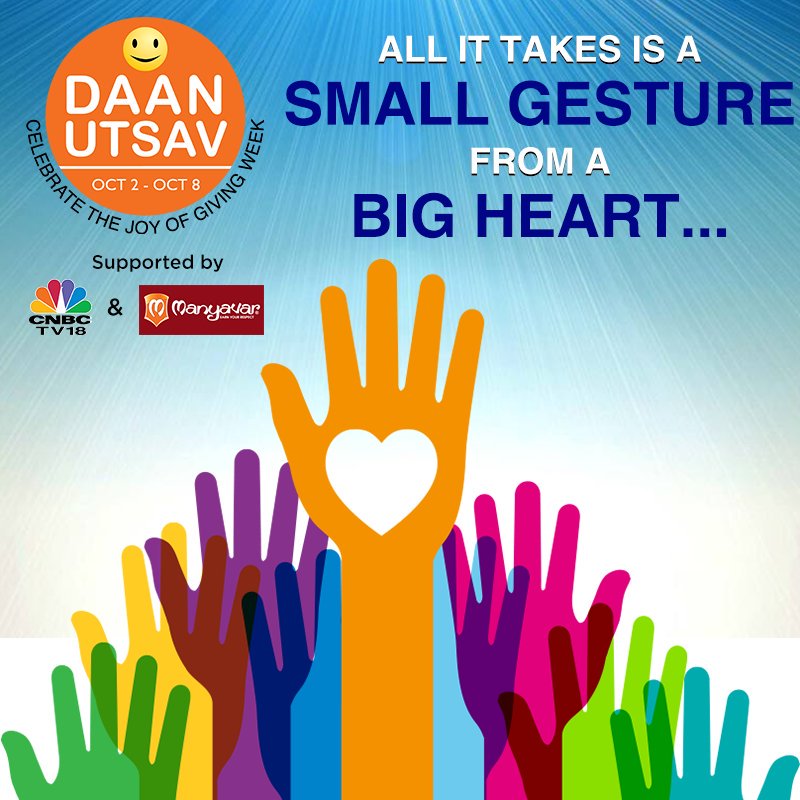Retail Giving
First, there is the rise of ‘retail giving’ or individual giving by ordinary citizens, which is bringing middle class individuals, especially young people, into the fold of philanthropy because of their desire to be a part of the solution.
They give, not because they have excess wealth to distribute; rather they are driven to do something that can make a change.
This trend is supported by use of technology platforms that makes it easier for givers and their circle of friends to get closer to change on the ground. More and more people from diverse backgrounds are engaged in the process and it leads to greater impact than just raising funds.
Last month, to mark India’s Children’s Day, Child Right and You (CRY) ran a #happychildhood campaign on social media with videos of CRY donors and supporters sharing their favorite childhood memories.
The campaign was not a direct call for donations. Instead, it tapped the innate empathy in people – the desire to recreate similar experiences for others, motivating them to give because they care.
 Another example is the DaanUtsav, which started in 2009 as Joy of Giving Week, and has become a tremendous success, engaging 6 to 7 million people today in the act of giving.
Another example is the DaanUtsav, which started in 2009 as Joy of Giving Week, and has become a tremendous success, engaging 6 to 7 million people today in the act of giving.
These examples show how retail giving is democratizing the process of giving, opening up avenues for raising awareness and leveraging the power of these large, networked platforms to mobilize and scale individual agency for social change.
The Rise of Progressive Philanthropists
Second, the report points to bold steps in giving by progressive individual philanthropists investing large sums of money in structural reforms in the areas of health, education, water and sanitation.
Most significantly, there is now a consortium of philanthropists visibly supportive of independent media. This comes at a time when independent media is under attack in the country, indicated, not least by the recent murder of journalist Gauri Lankesh.
By publicly investing in independent media, philanthropists with voices of influence such as Azim Premji and Rohini Nilekani are giving not just their dollars, but adding their power and influence to the cause as well, demonstrating the important role transparency has to play in making a difference.
‘In India a few people are emerging who are willing to put their money into such things – but it’s a slow burn’, says Rohini Nilekani, who along with her husband recently signed the Giving Pledge, committing to give away the majority of their wealth, at least $1.7 billion to philanthropy.
Furthermore, the report cites the emergence of a number of agencies in India like GuideStar India, Credibility Alliance, CAF India, and GiveIndia that are leading the NGO accrediting process to bridge the gap between NGOs and philanthropists – individuals, corporate, HNIs, foundations.
What is most interesting in this push for transparency? It is based on a model where NGOs are pushing for accountability from within, by voluntarily seeking this accreditation.
Citizen-Led Movements
Third, until now, citizen philanthropy-led, social movements have been unrecognized in their push to keep social change movements open, democratic, accountable and issue based.
The report draws attention to self-funded activist movements, notably the Right to Information Campaign, the Right to Work movement that succeeded on the strength of public support and not institutional philanthropy.
This trend signals that philanthropy is least effective in aiding social change when it plays into unequal power relationships between givers and receivers.
It is most effective when it is like a baton passed to wider communities who take center stage in exemplifying how giving, motivating and direct action can push systemic changes.
Despite increasing pressure on civil society now leading to shrinking spaces for communicating dissent against inequities and injustice, the report notes how many civil society organizations in every district and town of the country ‘have been able to mobilize and support citizens to claim access to their rights and to organize self-help efforts.’
These developments in India give a new meaning to transparency in philanthropy.
They shift the focus away from compliance to the role of philanthropy and the methods used by it, and places agency and power of the people center stage in this conversation. While the report points to this culture shift, it also points to areas for improvement, particularly the need for donor education.
Perhaps the agenda for donor education in India is best summed up by Pushpa Sundar in her book published earlier this year, Giving with a Thousand Hands: The Changing Face of Indian Philanthropy. She writes, ‘Philanthropy orientation has to change from ‘giving back’ to solving social problems.’
People are giving because they want to solve social problems through their own participation. It is time for them to get their due and for the field of institutional philanthropy to recognize that the real drivers of change are people.
Sumitra Mishra is executive director of Mobile Creches, working for the right to early childhood development, and former country director of iPartner India.
Chandrika Sahai is the coordinator of Philanthropy for Social Justice and Peace.
This post first appeared on Glasspockets – a service of the Foundation Centre, on Dec 13, 2017. The original post can be found here.








Comments (0)